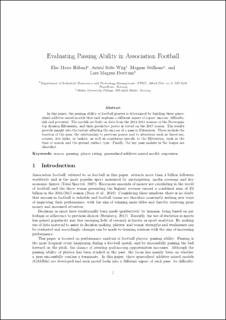Evaluating passing ability in association football
Peer reviewed, Journal article
Accepted version
Permanent lenke
https://hdl.handle.net/11250/3030510Utgivelsesdato
2020Metadata
Vis full innførselSamlinger
- Artikler [407]
- Publikasjoner fra Cristin [424]
Originalversjon
IMA Journal of Management Mathematics, 2020, 31 (1), 91-116 https://doi.org/10.1093/imaman/dpz004Sammendrag
In this paper, the passing ability of football players is determined by building three generalized additive mixed models that each explains a different aspect of a pass’ success: difficulty, risk and potential. The models are built on data from the 2014–2016 seasons of the Norwegian top division Eliteserien, and their predictive power is tested on the 2017 season. The results provide insight into the factors affecting the success of a pass in Eliteserien. These include the location of the pass, the relationship to previous passes and to situations such as throw-ins, corners, free kicks or tackles, as well as conditions specific to the Eliteserien, such as the time of season and the ground surface type. Finally, the key pass makers in the league are identified.
